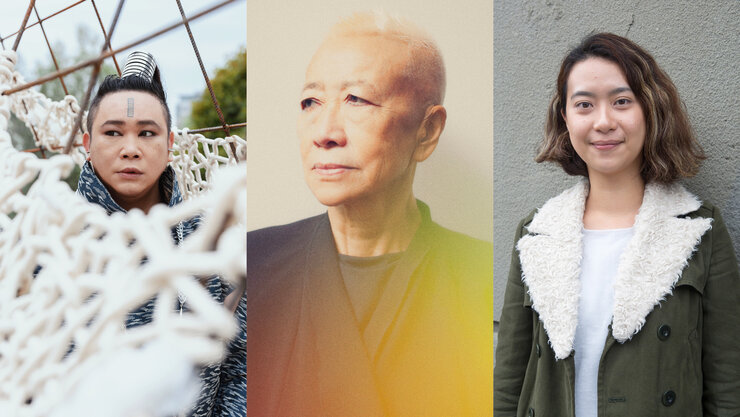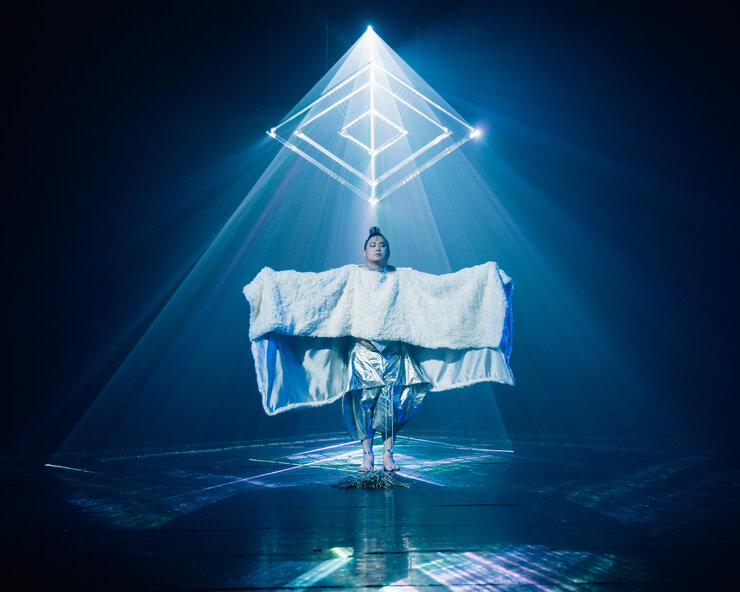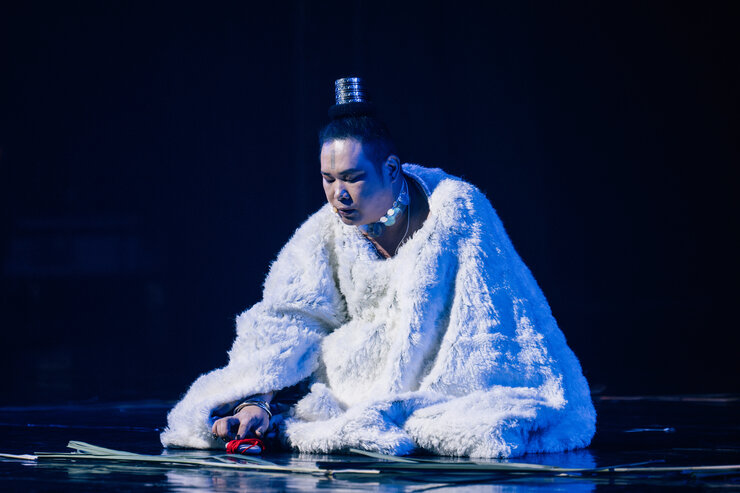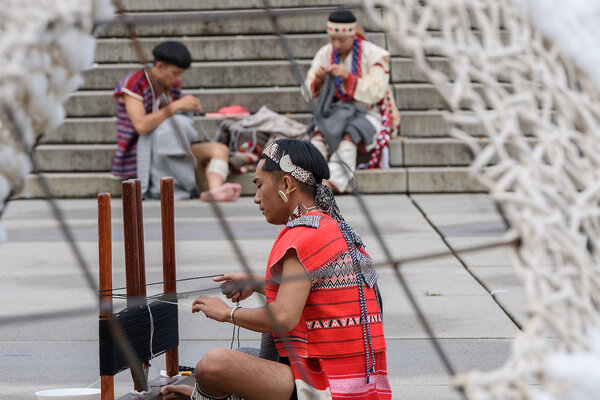
«In our understanding, we are all part of Gaya»
Shu Lea Cheang is one of today's most exciting multimedia artists and filmmakers. She works in a variety of media and formats, including installation, performance, net art, public art, video installation, feature film and mobile web series. Her artistic work is characterised by the imagination and the desire to transcend the boundaries of society, geography, politics and economic structures in order to redefine gender, roles and mechanisms. To this end, she also creates sci-fi narratives, such as the «Living Gaya Dreaming Hagay» universe, which she developed together with Dondon Hounwn and her team and which will be shown at the Zürcher Theater Spektakel in August.
Dondon Hounwn is an artist and shaman of the Truku indigenous people in Taiwan. His work is cross-media, cross-generational and cross-cultural, combining ancestral knowledge with an avant-garde, cross-gender aesthetic. His diverse background includes training in indigenous dance, music and theatre as well as working as a cultural manager and lecturer. Dondon Hounwn's works have been exhibited in numerous renowned galleries and museums, including the National Taiwan Museum of Fine Arts.
The interview with Lea Loeb, Shu Lea Cheang, Dondon Hounwn and Ping-Yi Chen took place on 5 July via Zoom in English and Mandarin. Lea Loeb took part from Zurich, Shu Lea Cheang and Ping-Yi Chen were connected from the metropolis of Taiwan, and Dondon Hounwn from his home village in the mountains of Taiwan.

Thank you Shu Lea, Dondon and Ping-Yi to do this interview today. We are looking forward to welcoming you to Zurich for the presentation of your work «Living Gaia Dreaming Hagay». It will be the very first time your work is presented in Switzerland. This is a joint project with Shedhalle Zürich, which will be presented at the festival. The presentation is part of a long term research project. Can you tell me more about it? I am also curious to hear more about your collaboration. How exactly do you work together as an artistic team and how did this collaboration start?
SLC: Our collaboration started in 2020. I was invited to curate a series of labs titled LAB KILL LAB at C-LAB (Taiwan Contemporary Culture Lab) in Taipei. Dondon was invited to lead Phytopia lab. He led a forest walk in the Dowmung mountains and created a prototype theatre performance based on the Hagay legend. I was immediately attracted to the Hagay as non-binary spiritual beings. I proposed to Dondon to further collaborate and develop the Gaya Living principle and the Hagay Dreaming stories into a formal theatre work. We invited Ping-Yi, who already was coordinating the lab project, to join as producer for «Hagay Dreaming», termed a techno-fantasia guided theatre of revival. We gave ourselves five years towards completing a large scale theatre work while the troupe actively engaged in presenting the work in various environments and formats, including the summer tour 2024, which starts at the Zürcher Theater Spektakel and Shedhalle and will go on to Denmark (Click Festival and Tofu Collective) and Lausanne (Platforme10). In 2025, we will finally present the full-length theatre version with Dance Reflections at Tate Modern in London.
Can you tell me more about the Gaya Living principle?
DH: Gaya is a principle and order of the society, the world, the cosmos held most valuable for Truku people, the indigenous tribe I come from. For us, Gaya is everywhere and everything. It applies either for individual or collective living, from death to birth, in continuation as an endless loop. Ultimately Gaya outlines a spiritual world – through the merging of body and soul to re-possess «snhiyi», a power of total trust. It is our way of understanding the world.
SLC: The Gaya Living principle understands all living creatures as connected, non-binary creatures. This worldview is a returning to the beginnings of Taiwan, in our tribal societies there was no binary gender perception. This changed through history, because of the colonial settlements of the Western world with its Christian missionaries, the Japanese rule, and then the mainland Chinese domination. When we talk about reconnecting with the Gaya principle in an artistic approach, it means reclaiming indigenous cosmos knowledge, in which a non-binary fluid gender is accepted.

The project consists of several parts: a performance, an exhibition and an installation. How are those three project levels connected?
SLC: The project has gone through various phases and stages. In 2022, it was premiered at the Dowmung Tribe Ceremony Space, followed by a durational site-specific performance at Stadwerkstatt in conjunction with Ars Electronica in Linz. Invited by the Taiwan Art Biennial, an installation and a performance/rehearsal was presented at the National Taiwan Museum. While developing «Hagay Dreaming» as a theatre work, we take every opportunity offered us to present the «development» of the work. This 2024 summer European tour is conceived as a cultural exchange project which allows us to further transmit the Gaya principle and the Hagay imaginations.
DH: For me, the project and the whole collaboration is like a river, like the river Mkruh near my home town of Haulien. The river brings all the elements together and merges them.
SLC: The name of the river translates to papaya in Chinese language!
PYC: No, it's actually not papaya, but then it sounds similar. Mkruh is the tribal name for the river. It means «behind» because its source is behind the mountain.
SLC: The topic of translation is actually a very interesting part of our collaboration. Dondon speaks the language of the Dowmung, a Truku tribe. A language that Ping-Yi and I don't understand. So the three of us communicate in Mandarin, the official language of Taiwan. Sometimes translation creates confusion or funny misunderstandings, like just now, I understood Mkruh river as papaya (Mugua) river (laughs).
Shu Lea, you have made a name for yourself in the visual arts and have already exhibited in major museums in Paris and New York. What is your relationship to Taiwan and especially to the indigenous communities in Taiwan?
SLC: I grew up in Taiwan, but it is true that I most of my artistic career as a visual artist and film maker has taken place in Europe and the US, i,e, in the Western world. Sometimes I get invited to Taiwan for exhibitions, such as representing Taiwan for the Venice Biennial 2019. Most of my presentations in Taiwan have not been developed in Taiwan. «Hagay Dreaming» marks a true engagement with Taiwan for me and –especially by working with Dondon of the Truku tribe – with its indigenous culture.
Dondon, in addition to your contemporary artistic work, you are a shaman of the Truku tribe. How do you bring these different aspects of your life together?
DH: I originally trained as a performer in Taipei. I moved there when I was quite young and continued to work and perform there for several years. During this time, far from my community, I began to delve deeper into the rituals of the Dowmung tribe. My grandmother had been a healer in our community. You would call this shaman in the West, but we actually call it healer. I started to take more interest in what my grandmother had taught me. So I began to learn and study more about that. At some point, I realised that I had a natural talent to become a healer. So I moved back to the village. Here, I almost only speak the language of our community. I have taken on the responsibility as a healer and I teach children and young people in our community. Actually, a lot about my work here has to do with performative art. Our language, for example, is very poetic. An example: When I wish someone «peace» in our language, I say: «I wish for you to walk like a lizard.» I find this a very poetic and artistic way of thinking and talking.
For me, my work in the community and my art can be combined very well. They complement each other. Through art, I can also talk about our culture and share it with others. Gaya, or the indigenous knowledge, and the artistic expression are really kind of the same to me.

The Hagay, whom the hunter dreams of, tell of fluid beings that move beyond the gender binary. How binary is the Truku's understanding of the world? And how is the topic of gender dealt with in Taiwanese society in general?
DH: Han culture, meaning the Chinese culture, is the dominant culture in Taiwan. Most of the population in Taiwan speak Mandarin and are very much influenced by Han culture. And of course by the colonial past. So the society in Taiwan is very binary. You can see that in the clothes, for example, that are very much gendered. This is very different in the indigenous communities. There are a total of 16 indigenous tribes in Taiwan. Some of them would, for example, wear female clothes as men in order to amuse the spirits. Our communities have no words for «queer», «gay» or «non-binary». Those concepts come from the West, from the colonisers. We have other concepts of being. In our understanding we are all part of Gaya.
PYC: Taiwan was actually the first country in Asia who legalised same sex marriage. But it is still a very binary society. For gay or non-binary people, life in Taiwan can be difficult as they still get stigmatised a lot.
In your work, you interweave tradition with fiction. And you sketch a non-binary, futuristic reality that relates to the beliefs and customs of the Truku tribe. I am very intrigued by the fusion of different aesthetics you propose. Can you tell me more about that?
SLC: When I got to know Dondon, I became intrigued by how I could connect my work – which is very much rooted in the world of media and technology – with Dondon's world. I have been working with electronics, video, sound, coding, motion capture, internet. So how can we combine new media aesthetics with the traditional way of performing tribal culture? How do we present ancient indigenous culture in this techno era? It has been inspirational and challenging as the tribal culture is so performative already. To merge technology with tribal cultures – i.e weaving, hunting, raining – express them in horizontal and vertical laser beams and weave a criss-cross of life. For the Shedhalle performance, we will mount a tribal totem with beaming laser light, which brings up the spiritual guidance and protection.

Weaving plays a central role in the project. How metaphorical is that?
DH: In the tribal language we say «Tminum». This word means weaving. Among the Han, weaving has always been a task for women. Not so for our communities. Weaving is non-binary in our understanding. Patterns like the totem can also be woven through these threads, and they are really powerful and strong. Weaving can bring different worlds together. It stands for the non-binary spirits and the spirits of Gaya.
Shu Lea and Dondon, I have one last question for you: You have very different perspectives on art, on Taiwan, and you also come from different generations. How does this collaboration feel like for you? What can you learn from each other?
DH: I can learn a lot from Shu Lea. She left Taiwan at a very young age and has lived abroad for so long. She has a very different perspective. I admire her and her work and have huge respect for her. Normally, it is the younger people who travel the world. Not in our case! For me, it is also new to work together remotely. We mostly speak on the phone or in video calls. I stay here in the village with my community and she travels a lot. But still we work very closely together and communicate a lot. This is new for me and inspiring.
SLC: I am learning quite a lot as well from Dondon and about the indigenous cultures in Taiwan. Being queer, I can relate very much to the Gaya principle of the non-binary nature. I am really happy to be working on this project with Dondon and Ping-Yi. It is a spiritual journey for all of us as we continue on the theatre presentation. As producer, Ping-Yi assumes a crucial role for the project. I would like her to say the closing words.
PYC: Well, Taiwan is quite famous for its technology, right? The Taiwanese government promotes the manufacturing of technology and understands that indigenous culture can be representative of Taiwan’s democratic governing. «Hagay Dreaming» combines these two cultural strongholds of Taiwan. Our project is very special and unique, and I have been learning so much, particularly about the Gaya spirits of the Turku community. I didn’t expect to gain so much knowledge from this journey. It has been a long process, requiring a lot of effort to advance the project, but it is incredibly rewarding.
I am looking forward to meeting the audience in Zurich!
Credits
Interview: Lea Loeb
Photos: ©SMITH, Petra Moser, Hsuan Lang Lin
translated from English into German by Franziska Henner